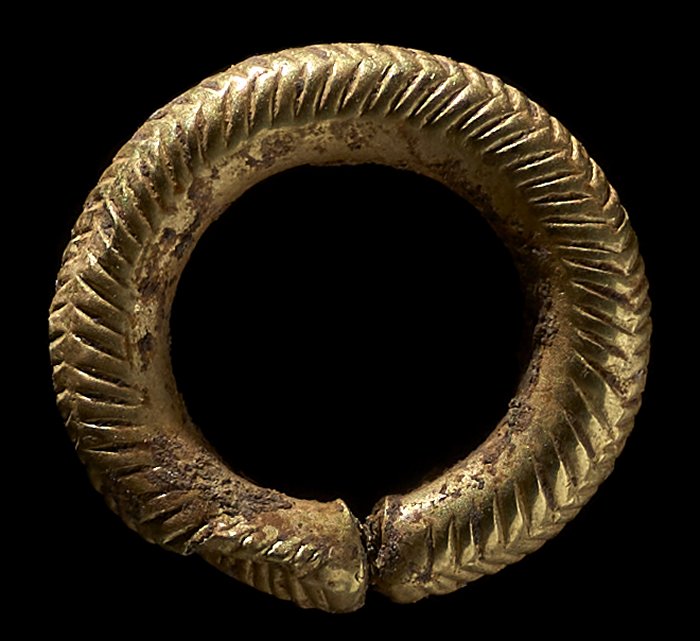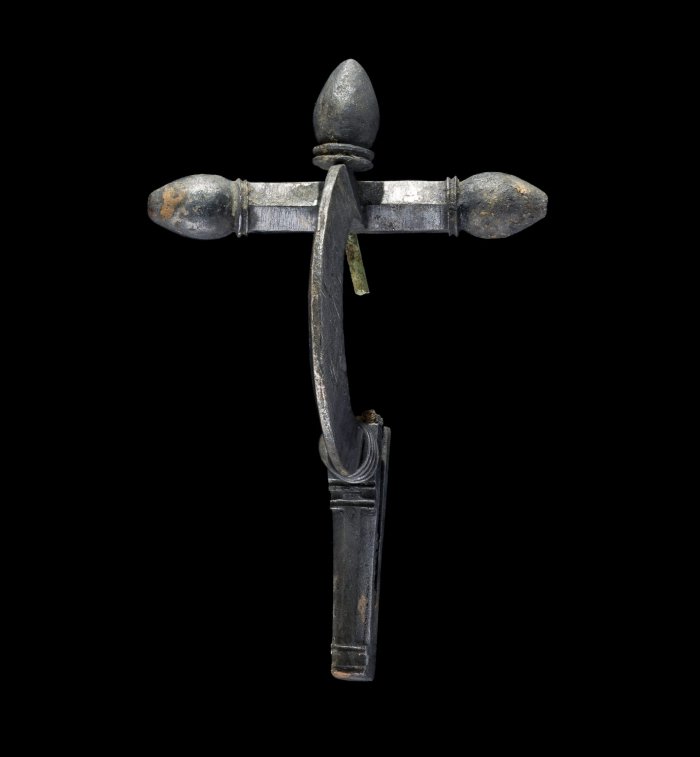Jan Bartek – AncientPages.com – Five treasure finds, including three hoards and two grave groups of Bronze Age and Roman date, were declared treasure on Tuesday 11th July 2023 by Area Coroner for South Wales Central, Patricia Morgan.
A Bronze Age grave group comprising a small gold penannular ring and fragments of a burnt wooden comb (Treasure Case 17.13) was discovered by Rubicon Heritage Services (Red River Archaeology Group). The find was made during archaeological excavations in St Nicholas and Bonvilston Community on 28th July 2017, as part of the archaeological work ahead of the A4426 Five Mile Lane improvements road scheme funded by the Welsh Government and delivered by Cyngor Bro Morgannwg – Vale of Glamorgan Council.

Image credit: Museum Wales
The two artifacts were found accompanying a human cremation burial in a small burial pit. This archaeological feature was carefully recorded before the burial and artifacts were removed. A licence was obtained from the Ministry of Justice, giving permission to remove the ancient human remains.
The gold penannular ring, just 1.1cm in diameter, is expertly made and decorated with a finely worked chevron or herringbone pattern. It is an early example of a class of object called a hair-ring, so-called as it is thought that it may have been used to decorate the hair. The fragmentary wooden comb has eight narrow and parallel teeth surviving and is now in a highly fragile state. It is an extremely rare survival of an organic artifact, its survival in the soil having been helped by its burnt charcoal state. These two artifacts, dating to the Middle Bronze Age (1300-1150 BC), were carefully selected as grave goods by grieving mourners, to accompany the deceased, cremated person to the afterlife.
Adam Gwilt, Principal Curator for Prehistory at Amgueddfa Cymru – Museum Wales said: “This cremation burial, with its accompanying gold ring and wooden comb, gives us a glimpse of life and death in Bronze Age times. The gold ring is a very early, well-made and small example of its type, offering new insight into the development of hair-rings as a form of early jewelry across Britain and Ireland. This grave is just one example of a much wider wealth of prehistoric burial evidence now being discovered across the Vale of Glamorgan, indicating the richness, diversity and significance of this archaeology and informing our wider understanding of the past.”
Amgueddfa Cymru – Museum Wales is interested in acquiring this find, following their independent valuation by the Treasure Valuation Committee. They will form part of the wider collection and archive from this archaeological excavation also destined for the national collection.
David Gilbert, Project Manager for Rubicon Heritage Services (Red River Archaeology Group) said: “The gold ring is obviously the most eye-catching object to accompany the cremation. However, the most important artifact is what may at first glance seem the more mundane: the wooden comb, which is a find without parallel in Wales, if not the UK.
Together, these lend the human element to our work, highlighting the importance of these objects to the person buried with them. Showing the attention to detail and pride in appearance missing from so many depictions of prehistoric people on television or in films. This discovery emphasizes the significant contribution made by commercial archaeology to advancing our detailed knowledge of the history of Wales.”
A Roman burial was excavated by Rubicon Heritage Services (Red River Archaeology Group) in April 2017, as part of the archaeological work ahead of A4426 Five Mile Lane improvements road scheme funded by the Welsh Government and delivered by Cyngor Bro Morgannwg – Vale of Glamorgan Council. The burial contained a silver crossbow brooch, the remains of an iron sword and hobnails from a pair of shoes.
This discovery emphasizes the significant contribution made by commercial archaeology to advancing our detailed knowledge of Wales’ history. The brooch being of silver and over 300 years old meant that the finds came within the remit of the Treasure Act (Treasure Case 17.06).
Crossbow brooches are a reasonably common type of Roman bow brooch well dated to the late third and fourth centuries AD. Most examples are of copper alloy although examples made of silver, or even gold, are known. The sword is an example of the longer type of sword used by the Roman army in the third and fourth centuries AD, which matches well with the dating of the brooch.
Evan Chapman, Senior Curator: Archaeology at Amgueddfa Cymru – Museum Wales said: “As far as I am aware this is the first example of a Roman silver crossbow brooch to be found in Wales. Crossbow brooches appear to have been ᴀssociated with the late Roman army and civil service, possibly originally being a badge of office, although it has been suggested that elements of military dress, including crossbow brooches, were embraced by the elite more widely.
The presence of the sword would support the military connection in this instance. Whether directly connected to the Roman army, or not, the brooch being of silver certainly suggests an individual of elite status.”
Amgueddfa Cymru – Museum Wales is looking to acquire these objects so that they can remain together with the rest of the finds from the excavations, which are already destined for the national collection.
Rachel Morgan, Project Archaeologist for Rubicon Heritage Services (Red River Archaeology Group) said: “The inhumation of a young man in military regalia was an unexpected discovery within a Roman field system. The silver crossbow brooch with which the individual was buried indicated his important status within the military or wider society.
He died sometime between the mid-3rd to late 4th century, at which time this style of brooch had become a symbol of imperial administrators, so he was unlikely to have been an ordinary soldier and was evidently of some wealth. Isotope analysis also revealed that he was not born locally but likely grew up further east, possibly from the Welsh borders or beyond, so what was this rich man doing on a farm in south Wales when he died?”
A Bronze Age hoard of tools and weapons (Treasure Case 20.22) was discovered by Richard Griffiths on 17th December 2020 while metal-detecting on a boggy field under pasture in Coychurch Higher Community, Bridgend. The hoard of seven bronze artifacts includes four fragmentary socketed axes, a spearhead, a palstave and a casting jet.
Dating to the Late Bronze Age (1000-800 BC), the hoard was once buried in a small and isolated pit feature, probably as part of a religious gift to the gods. To date, relatively few hoards of this date are known from the uplands of south Wales, so this find will allow for richer stories to be told about the people living in this area, around 3,000 years ago.
An archaeological findspot investigation of the findspot was undertaken by a small team of Amgueddfa Cymru and Portable Antiquities Scheme Wales (PAS Cymru) staff, with the help of the finder in August 2022.

Image credit: Museum Wales
Richard Griffiths, the metal-detectorist who found the hoard, said: “I was very excited about finding this Bronze Age hoard and I’m really chuffed to know that my find is now a part of our shared history. To think that I was the first person to hold these objects after the last person who used them, thousands of years ago, is a special thing for me.
I really enjoyed being involved with the museum archaeologists while they were doing their geophysics work and small dig. It was interesting to see how they worked, digging and recording everything very carefully. The extra find of the spearhead, still buried in the ground, was another unexpected extra twist to the story!”
Chris Griffiths, a researcher at Amgueddfa Cymru, who led the findspot investigation said: “The opportunity to investigate the location of this hoard was invaluable, and we’re extremely grateful for the help of both the landowner and Richard throughout this process. The discovery of a bronze spearhead during this investigation was the ‘icing on the cake’, giving us a fascinating insight into how Bronze Age people interacted with this upland landscape.”
Amgueddfa Cymru – Museum Wales is interested in acquiring this find, following their independent valuation by the Treasure Valuation Committee.
David Howell, Engagement Officer for the Portable Antiquities Scheme in Wales (PAS Cymru) said: “For 25 years, the Portable Antiquities Scheme in Wales has served to safeguard knowledge and information about the archaeology of Wales. During that time, PAS Cymru has recorded over 90,000 artefacts, building links with the metal-detecting community, and finders in general, to ensure that information about Welsh archaeology and history can be recorded and shared with the nation.”
A Bronze Age hoard (Treasure Case 21.15) was discovered by Peter Anning while metal-detecting in a field under pasture in Pontprennau Community, Cardiff on 30th October 2020. The hoard was first reported to Mark Lodwick via the Portable Antiquities Scheme in Wales (PAS Cymru). The hoard includes four blade fragments from a single leaf-shaped sword and two casting-jets, generated during the casting of bronze artifacts in clay moulds.
The sword fragments belong to a type known as a Ewart Park sword, while one of the casting-jets was created during the casting of a South Wales type socketed axe. They indicate the hoard dates to around 1000-800 BC during the Late Bronze Age. The artefacts were once carefully buried together in a small pit, probably as a religious offering.
The Museum of Cardiff is interested this find for its collection, after it has been independently valued by the Treasure Valuation Committee.
Alison Tallontire, Acting Museum Manager for the Museum of Cardiff, said: “We are really excited by the opportunity to acquire this hoard. The sword would be the first in the museum’s collection and a valued addition to our Bronze Age archaeology collection, which already includes a socketed axe, and the casting jets will add to this story of making such axes in Bronze Age Cardiff. Through acquiring this hoard, we will be able to expand our storytelling of this era and our collection from the Pontprennau area of Cardiff.”
Chris Griffiths, a doctoral student based at the University of Reading and Amgueddfa Cymru – Museum Wales said in a press statement: “It is uncommon to find multiple joining pieces of swords from south Wales, and so this hoard from Pontprennau Community, containing four blade fragments from a single sword, is a significant new find. Prior to its burial, the sword appears to have been cleanly broken into pieces, some of which are missing and may have been recycled to form other objects.
The manner in which this sword was broken, combined with the presence of two casting jets, suggests that a local bronzesmith was involved with the creation of this hoard, allowing us to imagine the kinds of people who lived in this part of Cardiff around 3,000 years ago.”
A small hoard of Roman coins (Treasure Case 21.18) was discovered by Shawn Hendry and Chris Perkins in May 2021 while metal-detecting on a field under pasture in Glascwm Community, Powys. The coin group comprises six silver coins, known as denarii, ranging in date from 32 BC to AD 161. The general Mark Antony and the emperors тιтus, Hadrian and Antoninus Pius are represented on the coins.
See also: More Archaeology News
The latest coin in the group could have been minted as late as AD 161, suggesting the coins were probably lost together between AD 145 and 165. Most of the coins were in circulation for a long-time before they were lost and the earliest coin, of Mark Antony (32-1 BC), is extremely worn. The coins were probably lost as a small purse group or as a small hoard.
Written by Jan Bartek – AncientPages.com Staff Writer





